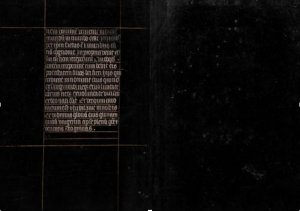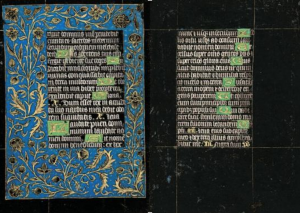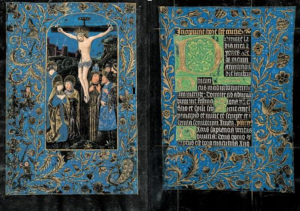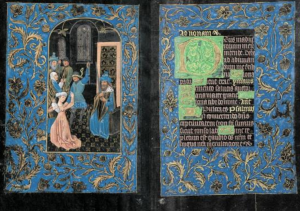The 15th century brought arguably the most elegant manuscripts ever created. Many of these manuscripts are known as books of hours or prayer books. These manuscripts set forth how and when to pray along with important biblical tales. The defining feature of many of these manuscripts are the extravagantly illustrated pages and images throughout the text. Telling a story as powerful as the text itself, these images served a crucial purpose in medieval manuscripts. Although there are dozens of these illuminated manuscripts, one stands out from the rest: The Black Hours. This manuscript provides an exemplary text in which the striking visuals of the manuscript tell the story behind the writing.
Starting at the cover, The Black Hours lacks the decay expected for the five centuries of its life. Practices during the 19th century led to changes such as the uncharacteristically new cover. Either in a preservation effort or for stylistic preferences, many 15th century manuscripts were rebound throughout the 19th century. Texts such as The Black Hours were and still are regarded as expensive and luxurious texts, as a result, improper and destructive use was unlikely. It can thereby be concluded that the rebinding of The Black Hours was a stylistic choice made by the owner at the time. Changes like this are unfortunate from a preservationist standpoint but provide context and a narrative of how this manuscript survived the centuries.

As pertaining to the name of the Manuscript, The Black Hours has stained black pages – or leaves – throughout the whole manuscript. Leaves such as this one (pictured right) showcase the deep black of the stained vellum. The most luxurious manuscripts used dried calf’s skin, or vellum, to create the pages. The creators of The Black Hours soaked the skin in a carbon-based mixture thus creating the midnight black material. To compensate for the black material, the author wrote with gold and silver ink. In addition to the highest quality material and gold ink, the illustrations and illuminations further continue the story behind this text.

Most pages in The Black Hours are either fully illuminated or containing more than one color of ink such as the following pages.These pages include intricate illuminations bordering the text as well as within. Highlighting important parts within a text was not an uncommon practice in the 15th century, however, a green ink was seldom used. Only used in the finest texts and in the smallest of quantities, green was difficult to acquire and signified the wealth of the owner of the book. The bordering illuminations come with a brilliant blue in stark contrast to the black pages. The intricate gold and silver foliage pattern completes the border, further accenting the colors within the text. In addition to many pages containing the vibrant blue border, there are 14 pages which contain detailed illustrations.

The images throughout The Black Hours often use the black background along with special color combinations to create a stunning image. The first image depicts Jesus’s crucifixion. (image left)

Another rare ink used in many of the images is a flesh tone and rosy color. Seen across the faces of the bystanders as well as Jesus’s bare body, these inks were not used sparingly. The artist also is clearly talented with their use of the blackened vellum to create clothing for surrounding spectators. In addition to the illustration, the following page contains an exaggerated first letter highlighted with the green ink. This is repeated across the manuscript with images such as “The Massacre of The Innocents.” (image right) This image has extensive use of the rosy ink as well as the large illuminated letter to start the text on the following page. The illustrations throughout The Black Hours serve an informational purpose to depict these important scenes within the religion as well as displaying the quality of this manuscript. A number of images throughout a manuscript help price the book and determine to whom the book belonged.
From the 19th century binding to the expensive materials used in its creation, The Black Hours not only sets forth prayers but also carries the stories of the centuries of use. Today, The Black Hours is kept as part of The Pierpont Morgan Library’s collection of manuscripts. Unfortunately, the centuries have affected this beautiful manuscript as the pages have begun to flake. The carbon stain which identifies this text is the reason behind its decay. In a preservation effort, The Morgan Library has digitalized all 124 leaves of the manuscript. It is unclear the steps towards restoration but one can only hope such a precious and unique manuscript can be saved.